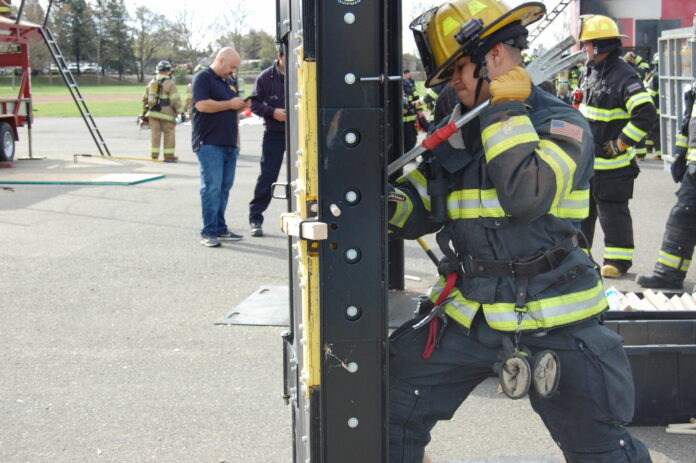Around 40 firefighters from departments and agencies across Sonoma County gathered at the Healdsburg Community Center on a chilly Sunday morning, March 8, for the second day of a free live fire training with the Kelseyville Fire Protection District training trailer.
The class included participants from Healdsburg, Geyserville, North Sonoma Coast, Graton Fire District, Dry Creek Rancheria, Cordelia, Mill Valley, Sonoma County Fire District (which incorporates Windsor, Rincon Valley, Bennet Valley and Mountain fire districts), CalFire, Monte Rio, Russian River, San Francisco and Wilton.
The live fire training rig travels to different locations throughout the state to give new recruits, volunteers and full-time firefighters the chance to brush up on structure fire training within a safe and controlled environment.
Training sessions are made possible by a grant secured through the California State Firefighters’ Association (CSFA).
In the fall of 2018, CSFA wa awarded with a statewide $2 million grant for 2018 through November 2022. The grant aims to provide training, physicals and firefighter recruitment and retention workshops.
“Part of the grant is live fire training and I believe it is at eight locations a year… and anybody in the state can come to this because we target different locations, it is not limited to Sonoma County,” said Vern Losh, chair of the political action committee with CSFA.
The burn trailer itself is a large semi-trailer converted into what looks like a house on the inside with a bedroom, kitchen, stove and a small upstairs section. It is also equipped with a plywood roof prop so participants can cut a ventilation hole to allow for vertical smoke ventilation.
A master controller works at the control center and controls the intensity and frequency of the flames in the trailer, which is propane powered.
Kelseyville Fire Protection District Chief Joe Huggins was behind the controls throughout the training.
Before participants started the exercise, Huggins gave an orientation and split the participants into small teams of four.
Temperatures inside the trailer reached about 350 degrees Fahrenheit near the ground of the trailer and upwards of 1,000 degrees Fahrenheit on surfaces and throughout the inside, Huggins said when walking through the trailer with the participants, all of whom were suited up in full turn-out gear, eye protection and breathing apparatus.
“We teach them to stay low from the smoke where the fresh air is and where they can see better too,” Losh said.
They also learn how to properly crawl, read the flames, work with saws and axes, and how to advance the hose lines.
At around 10 a.m. Huggins fired up the trailer and the first team of four climbed into the bright red rig, smoke billowing out of the doors and windows.
Within a few minutes the fire was out, the crew pulled out the hose and the exercise was repeated.
“It is almost the adrenaline rush of a real fire because you got the flame and the heat and your body is going to sense all of that and feel what it will be like going through a simulation,” Losh said.
Huggins said the training session is a good opportunity because, according to Huggins, live fire training is hard to come by.
Ron Busch, the battalion chief of training for the Sonoma County Fire District, said these types of exercises are beneficial because it helps firefighters gain confidence in using their equipment and breathing apparatuses and helps them learn about fire behavior.
“The number of fires we have on an annual basis is not what it used to be,” he said, so a live fire training with a house fire scenario is a “good refresher.” Grey Chandler, who has been a volunteer firefighter with the Healdsburg Fire Department for three years, said with any profession, providing the utmost level of customer care is important and training helps with being able to provide good service.
“Our job is about service to the community and whether it is a restaurant or a fire department, we are doing our utmost for the customer,” Chandler said. “I allude it to a restaurant because I love to cook. You are always trying new dishes, you’re using the best ingredients and when it comes to firefighting you are dealing with people’s lives and their livelihood, life, property and then the environment, and that is a big thing to be gambling with and so it is our utmost responsibility to train everyday on the basics, low- risk and high frequency events.” Chandler continued, “It allows us as volunteers … to really get hands-on and get experience on something that we don’t get all of the time.”
Representatives from the Blue Collar Training Network were also on scene to provide forcible entry training.
“Today we are teaching forcible entry, which is a basic skill that firefighters need on the fireground, basically getting through different ypes of doors, residential and commercial,” said Joe Schuller of Blue Collar training. “We will show them different ways to do it and give them the opportunity to get some reps in. A lot of people don’t have the opportunity to have the props, so that is what we are doing today.”
Tools used in forcible entry training included a halligan bar multi-tool, sledge hammer and an axe. While teams trained in the trailer, firefighters from the Sonoma County Fire District worked with the entry exercise.
Losh said this time of year is a good time to train since it’s not too busy and is ahead of the fire season.
“Right now there’s not a lot of wildland fires going on so we can focus on structure fire training,” and overall, “They will learn quite a few skills,” Losh said.








